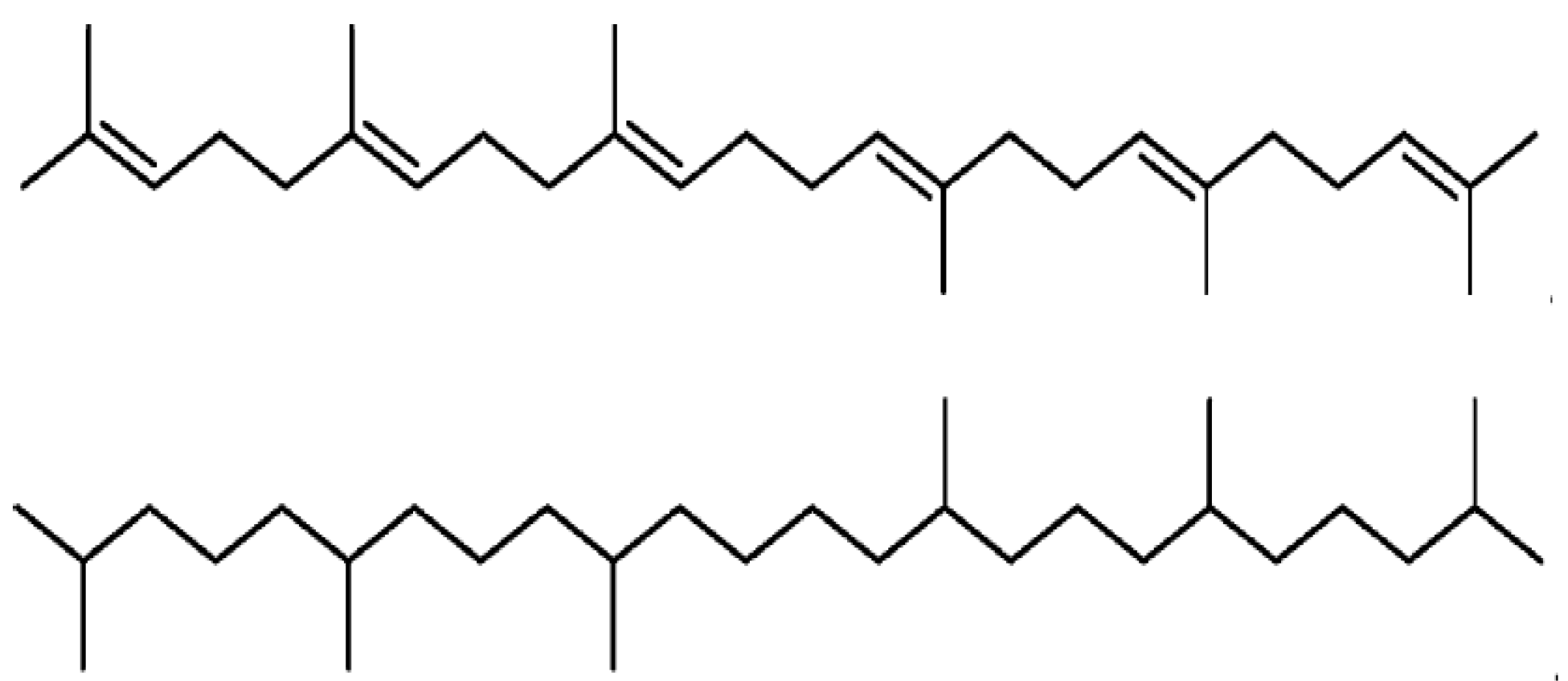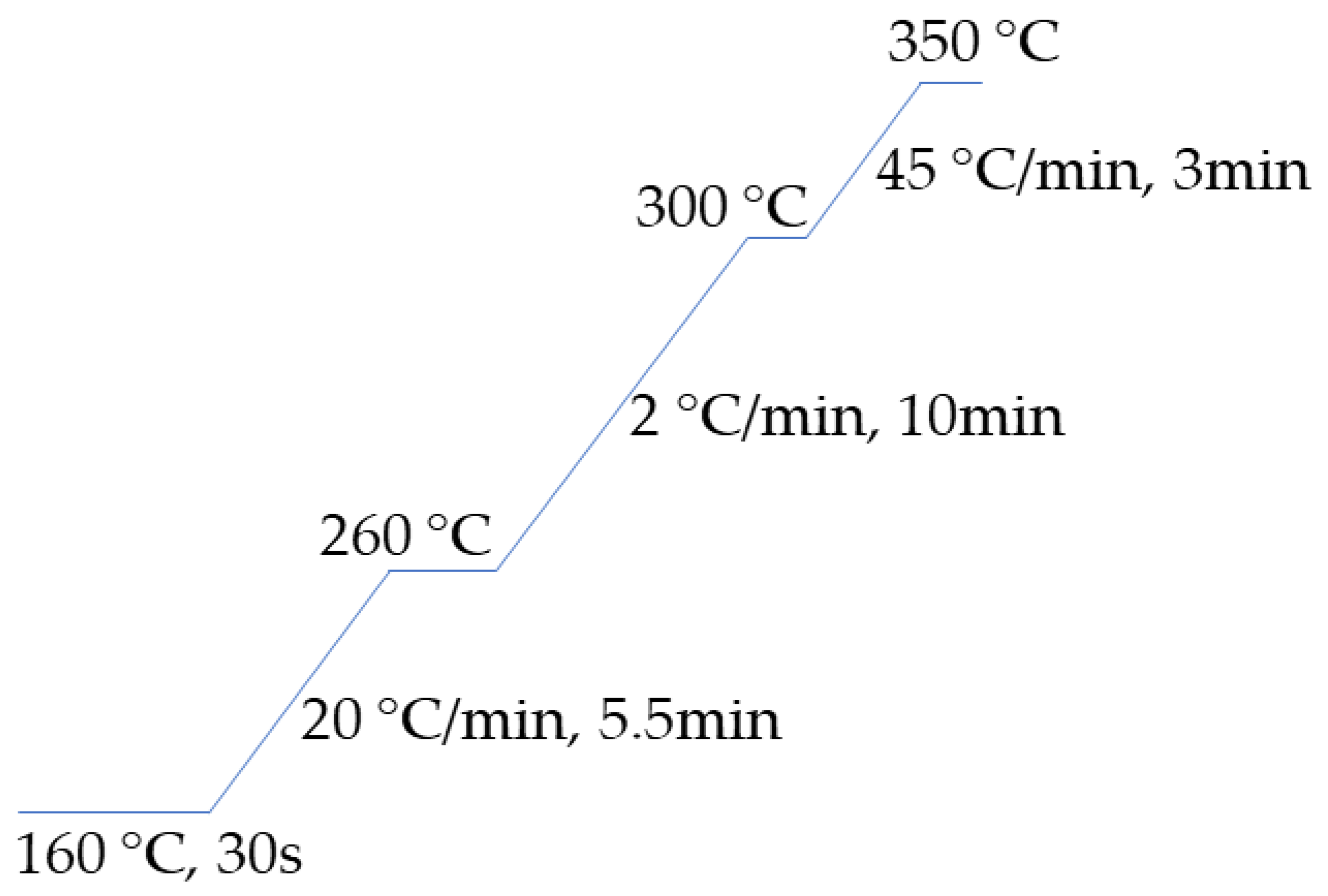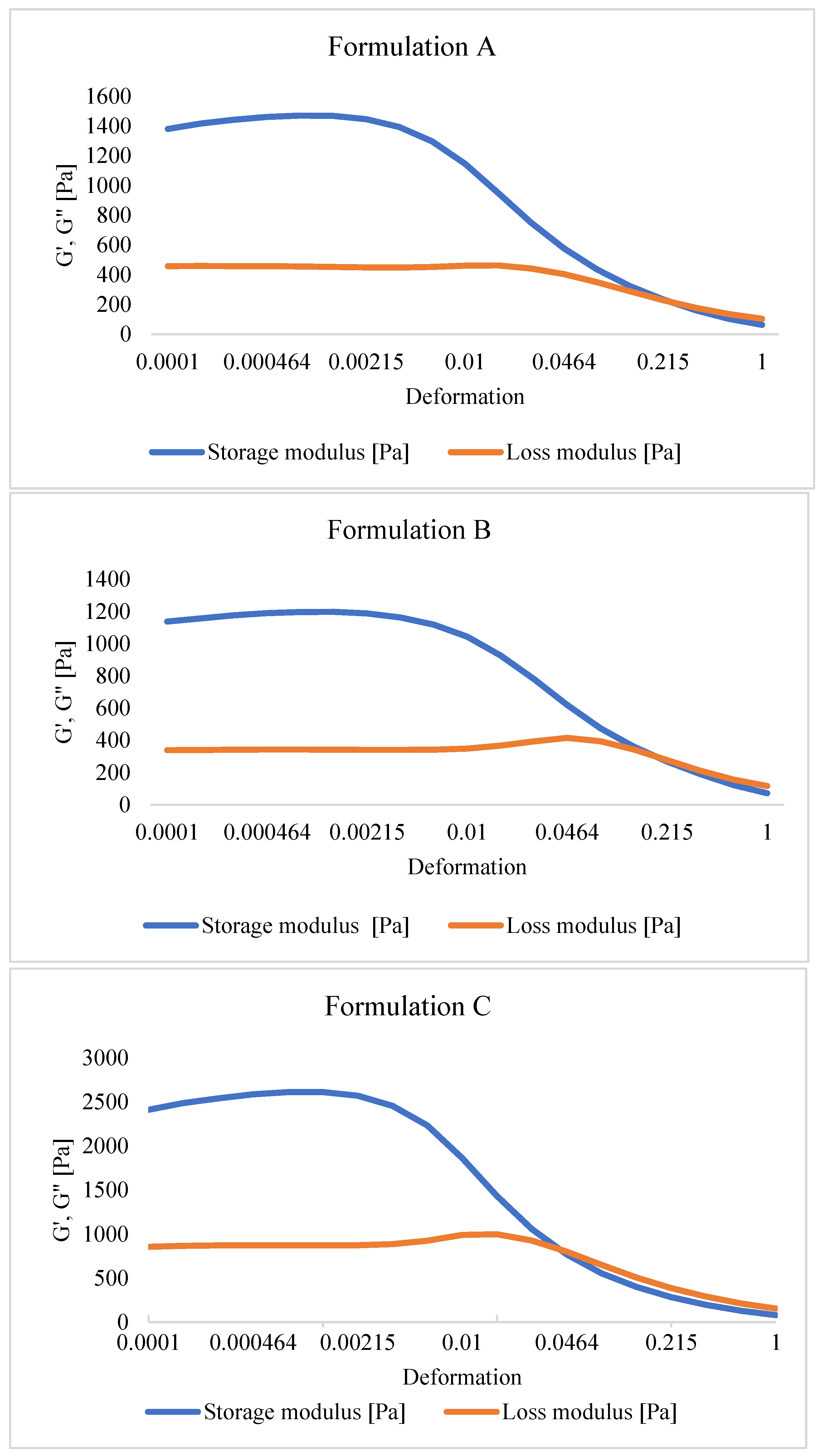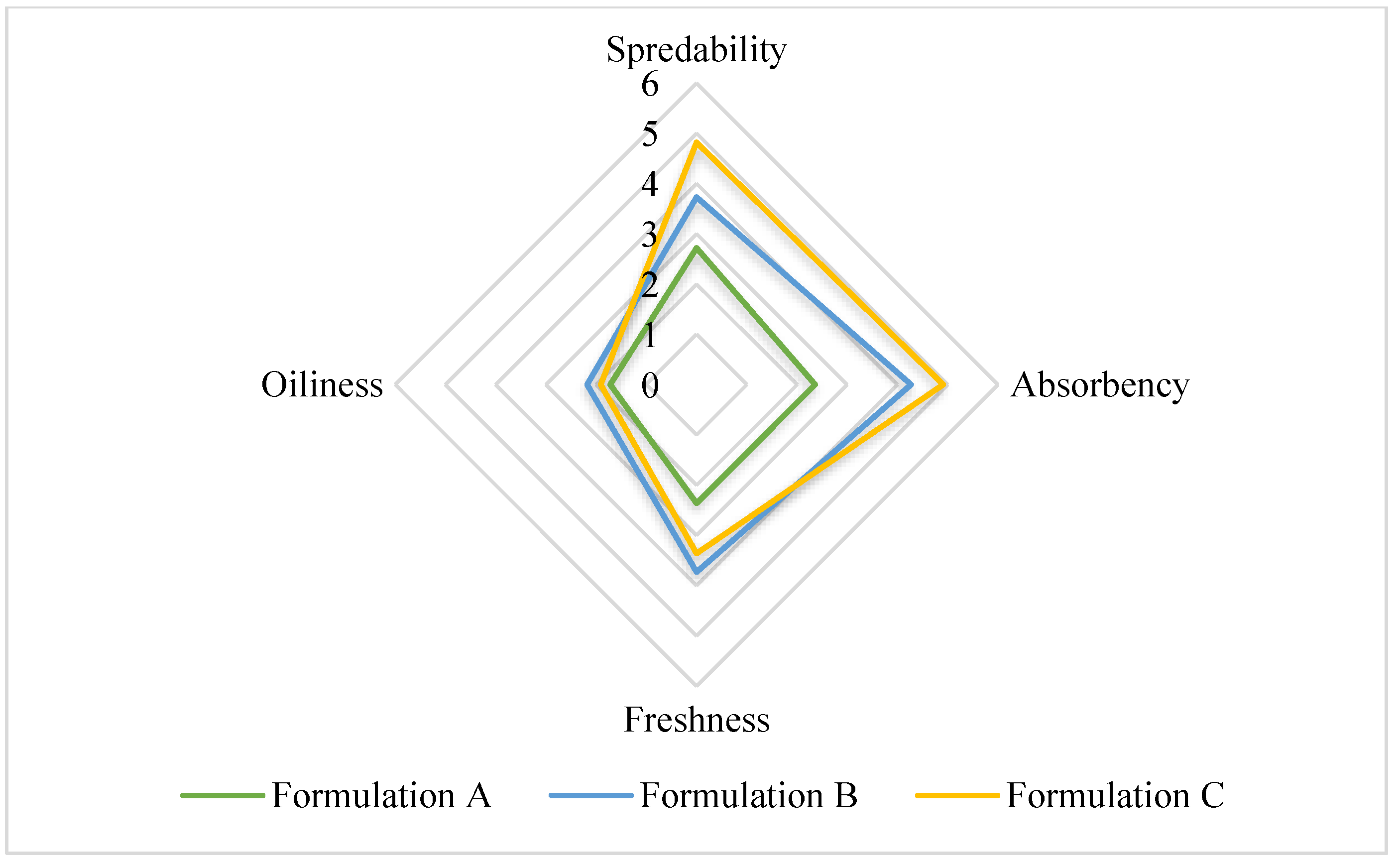Amaranth Oilseed Composition and Cosmetic Applications
Abstract
1. Introduction
2. Materials and Methods
2.1. Vegetable Oil Extraction
2.2. Fatty Acid Analysis
2.3. Extraction and Identification of the Unsaponifiable Fraction
2.4. Catalytic Hydrogenation of Amaranth oil Processes (Typical Procedure)
Quantitative Determination of Platinum
2.5. Water-in-Oil Moisturizing Cream Formulations
2.5.1. Measurement of Rheological Properties
2.5.2. Determination of Peroxide Value
2.5.3. Sensory Evaluation
2.6. Statistical Analysis
3. Results and Discussion
3.1. Fatty Acid and Unsaponifiable Composition of Amaranth Oilseed
3.2. Catalytic Hydrogenation of Amaranth Oil
3.3. Rheological Properties Analysis
3.4. Peroxide Index Analysis
3.5. Sensory Profile Analysis
4. Conclusions
Author Contributions
Funding
Institutional Review Board Statement
Informed Consent Statement
Data Availability Statement
Acknowledgments
Conflicts of Interest
References
- Budin, J.T.; Breene, W.M.; Putnam, D.H. Some compositional properties of seeds and oils of eight Amaranthus species. J. Am. Oil Chem. Soc. 1996, 73, 475–481. [Google Scholar] [CrossRef]
- Joshi, D.C.; Sood, S.; Hosahatti, R.; Kant, L.; Pattanayak, A.; Kumar, A.; Yadav, D.; Stetter, M.G. From zero to hero: The past, present and future of grain amaranth breeding. Appl. Genet. 2018, 131, 1807–1823. [Google Scholar] [CrossRef] [PubMed]
- Evon, P.; De Langalerie, G.; Ramaux, T.; Labonne, L.; Ballas, S.; Véronèse, T.; Merah, O.; Talou, T.; Ouagne, P. Amaranth, a model for the future biorefinery of whole plants. Plant Fibres and Biopolymers for Biobased Materials and Composites Applications, Proceedings of Gdr Symbiose & Flower Project, Nantes, France, 24–26 April 2019, 2019; unpublished. [Google Scholar]
- Evon, P.; De Langalerie, G.; Labonne, L.; Merah, O.; Talou, T.; Ballas, S.; Véronèse, T. Innovative low-density blocks from amaranth pith for the thermal insulation of buildings. In Proceedings of the 15th International Conference on Renewable Resources & Biorefineries, Toulouse, France, 3–5 June 2019. [Google Scholar]
- Gamel, T.H.; Linssen, J.P.; Mesallam, A.S.; Damir, A.A.; Shekib, L.A. Seed treatments affect functional and antinutritional properties of amaranth flours. J. Sci. Food Agric. 2006, 86, 1095–1102. [Google Scholar] [CrossRef]
- Gamel, T.H.; Mesallam, A.S.; Damir, A.A.; Shekib, L.A.; Linssen, J.P. Characterization of amaranth seed oils. J. Food Lipids 2007, 14, 323–334. [Google Scholar] [CrossRef]
- Kachiguma, N.K.; Mwase, W.; Maliro, M.; Damaliphetsa, A. Chemical and mineral composition of amaranth (Amaranthus L.) Species Collected from Central Malawi. J. Food Res. 2015, 4, 92–102. [Google Scholar] [CrossRef]
- Ologunde, M.O.; Ayorinde, F.O.; Shepard, R.L.; Afolabi, O.A.; Oke, O.L. Sterols of seed oils of Vernonia galamensis, Amaranthus cruentus, Amaranthus caudatus, Amaranthus hybridus and Amaranthus hypochondriacus grown in the humid tropics. J. Sci. Food Agric. 1992, 58, 221–225. [Google Scholar] [CrossRef]
- Ogrodowska, D.; Zadernowski, R.; Czaplicki, S.; Derewiaka, D.; Wronowska, B. Amaranth Seeds and Products—The Source of Bioactive Compounds. Pol. J. Food Nutr. Sci. 2014, 64, 165–170. [Google Scholar] [CrossRef]
- Rastogi, A.; Shukla, S. Amaranth: A new millennium crop of nutraceutical values. Crit. Rev. Food Sci. Nutr. 2013, 53, 109–125. [Google Scholar] [CrossRef]
- León-Camacho, M.; Garcia-González, D.L.; Aparicio, R. A detailed and comprehensive study of amaranth (Amaranthus cruentus L.) oil fatty profi le. Eur. Food Res. Technol. 2001, 213, 349–355. [Google Scholar] [CrossRef]
- Hunter, T.N.; Pugh, R.J.; Franks, G.V.; Jameson, G.J. The role of particles in stabilising foams and emulsions. Adv. Colloid Interface Sci. 2008, 137, 57–81. [Google Scholar] [CrossRef]
- Smaoui, S.; Hlima, B.; Jarraya, R.; Kamoun, N.G.; Ellouze, R.; Damak, M. Cosmetic emulsion from virgin olive oil: Formulation and bio-physical evaluation. Afr. J. Biotechnol. 2012, 11, 9664–9671. [Google Scholar] [CrossRef]
- Khan, B.A.; Akhtar, N.; Mahmood, T.; Qayum, M.; Uz-Zaman, S. Formulation and pharmaceutical evaluation of a W/O emulsion of Hippophae rhamnoides fruit extract. J. Pharm. Res. 2010, 3, 1342–1344. [Google Scholar]
- Tsimidou, M.Z. Squalene and tocopherols in olive oil. In Olives and Olive Oil in Health and Disease Prevention; Preedy, V., Watson, R., Eds.; Elsevier: Amsterdam, The Netherlands, 2010; pp. 561–567. [Google Scholar]
- Lozano-Grande, M.A.; Gorinstein, S.; Espitia-Rangel, E.; D’avila-Ortiz, G.; Martínez-Ayala, A.L. Plant Sources, Extraction Methods, and Uses of Squalene. Int. J. Agron. 2018, 2018, 1829160. [Google Scholar] [CrossRef]
- Huang, Z.-R.; Lin, Y.-K.; Fang, J.-Y. Biological and Pharmacological Activities of Squalene and Related Compounds: Potential Uses in Cosmetic Dermatology. Molecules 2009, 14, 540–554. [Google Scholar] [CrossRef] [PubMed]
- Lidgate, D.M.; Byars, N.E. Development of an Emulsion-Based Muramyl Dipeptide Adjuvant Formulation for Vaccines. In Vaccine Design, the Subunit and Adjuvant Approach; Powell, M.F., Newman, M.J., Eds.; Springer Nature: Lausanne, Switzerland, 1995; pp. 313–324. [Google Scholar]
- Camin, F.; Bontempo, L.; Ziller, L.; Piangiolino, C.; Morchio, G. Stable isotope ratios of carbon and hydrogen to distinguish olive oil from shark squalene-squalane. Rapid Commun. Mass Spectrom. 2010, 24, 1810–1816. [Google Scholar] [CrossRef]
- Aburjai, T.; Aburjai, T.; Natsheh, F.M. Plants Used in Cosmetics. Phytother. Res. 2003, 17, 987–1000. [Google Scholar] [CrossRef] [PubMed]
- Popa, O.; Băbeanu, N.E.; Popa, I.; Nită, S.; Dinu-Pârvu, C.E. Methods for obtaining and determination of squalene from natural sources. BioMed Res. Int. 2015, 2015, 367202. [Google Scholar] [CrossRef]
- Auguet, C.; Casanovas, A.; Celades, R. A new source of squalane. Drug Cosmet. Ind. 1988, 143, 151–153. [Google Scholar]
- Ciriminna, R.; Pandarus, V.; Béland, F.; Pagliaro, M. Catalytic Hydrogenation of Squalene to Squalane. Org. Process. Res. Dev. 2014, 18, 1110–1115. [Google Scholar] [CrossRef]
- Wu, C.; Tsay, Y.; Liou, H. Studies on the Content and Hydrogenation Condition of Squalene from the Liver Oil of Deep Sea Sharks. J. Fish Soc. Taiwan 1980, 7, 43–55. [Google Scholar]
- McPhee, D.; Pin, A.; Kizer, L.; Perelman, L. Deriving renewable squalane from sugarcane. Cosmet. Toilet. 2014, 129, 20–26. [Google Scholar]
- Martirosyan, D.M.; Miroshnichenko, L.A.; Kulakova, S.N.; Pogojeva, A.V.; Zoloedov, V.I. Amaranth oil application for coronary heart disease and hypertension. Lipids Health Dis. 2007, 6, 1–12. [Google Scholar] [CrossRef] [PubMed][Green Version]
- Ryan, E.; Galvin, K.; O’connor, T.P.; Maguire, A.R.; O’Brien, N.M. Phytosterol, squalene, tocopherol content and fatty acid profile of selected seeds, grains, and legumes. Plant Food Hum. Nutr. 2007, 62, 85–91. [Google Scholar] [CrossRef] [PubMed]
- Kim, J.; Yu, J.; Lee, S.; Tahmasebi, A.; Jeon, C.-H.; Lucas, J. Advances in catalytic hydrogen combustion research: Catalysts, mechanism, kinetics, and reactor designs. Int. J. Hydrogen Energy 2021, 46, 40073–40104. [Google Scholar] [CrossRef]
- Sapino, S.; Carlotti, M.E.; Peira, E.; Gallarate, M. Hemp-seed and olive oils: Their stability against oxidation and use in O/W emulsions. Int. J. Cosmet. Sci. 2005, 27, 355. [Google Scholar] [CrossRef]
- Singhal, R.S.; Kulkarni, P.R. Effect of puffing on oil characteristics of Amaranth (Rajgeera) seeds. J. Am. Oil Chem. Soc. 1990, 67, 952–954. [Google Scholar] [CrossRef]
- Palombini, S.V.; Claus, T.; Maruyama, S.A.; Gohara, A.K.; Souza, A.H.P.; De Souza, N.E.; Visentainer, J.V.; Gomes, S.T.M.; Matsushita, M. Evaluation of nutritional compounds in new amaranth and quinoa cultivars. Food Sci. Technol. 2013, 33, 339–344. [Google Scholar] [CrossRef]
- Becker, R.; Wheeler, E.L.; Lorenz, K.; Stafford, A.E.; Grosjean, O.K.; Betschart, A.A.; Saunders, R.M. A Compositional Study of Amaranth Grain. J. Food Sci. 1981, 46, 1175–1180. [Google Scholar] [CrossRef]
- Lyon, C.K.; Becker, R. Extraction and refining of oil from amaranth seed. J. Am. Oil Chem. Soc. 1987, 64, 233–236. [Google Scholar] [CrossRef]
- Sales-Campos, H.; De Souza, P.R.; Peghini, B.C.; Da Silva, J.S.; Cardoso, C.R. An overview of the modulatory effects of oleic acid in health and disease. Mini Rev. Med. Chem. 2013, 13, 201–210. [Google Scholar] [CrossRef]
- Loden, M. Role of Topical Emollients and Moisturizers in the Treatment of Dry Skin Barrier Disorders. Am. J. Clin. Derm. 2003, 4, 771–788. [Google Scholar] [CrossRef]
- Berganza, B.E.; Moran, A.W.; Rodríguez, G.M.; Coto, N.M.; Santamaría, M.; Bressani, R. Effect of variety and location on the total fat, fatty acids and squalene content of amaranth. Plant Food Hum. Nutr. 2003, 58, 1–6. [Google Scholar] [CrossRef]
- Hlinková, A.; Bednárová, A.; Havrlentová, M.; Šupová, J.; Čičová, I. Evaluation of fatty acid composition among selected amaranth grains grown in two consecutive years. Biologia 2013, 68, 641–650. [Google Scholar] [CrossRef]
- Czaplicki, S.; Ogrodowska, D.; Zadernowski, R.; Derewiaka, D. Characteristics of Biologically-Active Substances of Amaranth Oil Obtained by Various Techniques. Pol. J. Food Nutr. Sci. 2012, 62, 235–239. [Google Scholar] [CrossRef]
- Grajeta, H. Nutritive value and utilization of amaranth. Bromat Chem. Toksykol. 1997, 30, 17–23. (In Polish) [Google Scholar]
- Marcone, M.F.; Kakadu, Y.; Yada, R.Y. Amaranth as a rich dietary source of β-sitosterol and other phytosterols. Plant Food Hum. Nutr. 2004, 58, 207–211. [Google Scholar] [CrossRef]
- Kaleem, A.; Aziz, S.; Iqtedar, M.; Abdullah, R.; Aftab, M.; Rashid, F.; Shakoori, F.R.; Naz, S. Investigating Changes and Effect of Peroxide Values in Cooking Oils Subject to Light and Heat. Fuuast J. Biol. 2015, 5, 191–196. [Google Scholar]
- Rajah, K.K. Fat Products Using Fractionation and Hydrogenation. In Fats in Food Products; Moran, D.P.J., Rajah, K.K., Eds.; Springer Nature: Boston, MA, USA, 1994; pp. 277–317. [Google Scholar]
- Pandarus, V.; Ciriminna, R.; Kaliaguine, S.; Béland, F.; Pagliaro, M. Heterogeneously Catalyzed Hydrogenation of Squalene to Squalane under Mild Conditions. ChemCatChem 2015, 7, 2071–2076. [Google Scholar] [CrossRef]
- Ibănescu, C.; Danu, M.; Nanu, A.; Lungu, M.; Simionescu, B.C. Stability of disperse systems estimated using rheological oscillatory shear tests. Rev. Roum. Chim. 2010, 55, 933–940. [Google Scholar]
- Megnanou, R.-M.; Niamke, S. Improving the optimized shea butter quality: A great potential of utilization for common consumers and industrials. Springerplus 2015, 4, 667–671. [Google Scholar] [CrossRef]
- Lupi, F.R.; Gabriele, D.; De Cindio, B.; Sánchez, M.C.; Gallegos, C. A rheological analysis of structured water-in-olive oil emulsions. J. Food Eng. 2011, 107, 296–303. [Google Scholar] [CrossRef]
- Thorgeirsdóttir, T.Ó.; Thormar, H.; Kristmundsdóttir, T. Viscoelastic Properties of a Virucidal Cream Containing the Monoglyceride Monocaprin: Effects of Formulation Variables: A Technical Note. AAPS PharmSciTech 2006, 7, E44. [Google Scholar] [CrossRef] [PubMed][Green Version]
- Mydul Alam, M.; Ushiyama, K.; Aramaki, K. Phase Behavior, Formation, and Rheology of Cubic Phase and Related Gel Emulsion in Tween80/Water/Oil Systems. J. Oleo Sci. 2009, 58, 361–367. [Google Scholar] [CrossRef] [PubMed]
- Moigradean, D.; Poiana, M.-A.; Gogoasa, I. Quality characteristics and oxidative stability of coconut oil during storage. J. Agroaliment. Process. Technol. 2012, 18, 272–276. [Google Scholar]
- Moneim, A.; Sulieman, E.; Mohammed, M.B.; Ali, A.O. Physicochemical and Sensory Properties of Traditionally and Laboratory Made Ghee (Samin) of the Sudan. Int. J. Food Sci. Nutr. Eng. 2013, 3, 7–11. [Google Scholar] [CrossRef]
- Govind Rao, M.K.; Achaya, K.T. Antioxidant activity of squalene. J. Am. Oil Chem. Soc. 1968, 45, 296. [Google Scholar] [CrossRef]





| Squalene Origin | Catalyst Type | H2 Pressure (Bar) | Temperature (°C) | Time (Hour) | Ref. |
|---|---|---|---|---|---|
| Shark liver oil | 0.05% nickel-kieselguhr | 4 | 200 | 3–4 | [24] |
| Olive oil | Ni-based | 5 bar/30 bar | 200 | 4 h/3 h | [23] |
| Sugarcane | 5% Pd/C | 150 | 160 | 16 | [25] |
| Experiments | 5% Pt/C Mass (mg) | Pressure Conditions (Bars) |
|---|---|---|
| 1 | 100 | 10 |
| 2 | 200 | 10 |
| 3 | 250 | 10 |
| 4 | 200 | 20 |
| 5 | 250 | 20 |
| Phase | Ingredients (INCI Name) | Content (wt.%) | ||
|---|---|---|---|---|
| Formulation A | Formulation B | Formulation C | ||
| Phase A (aqueous) | Aqua/water | 57 | 57 | 57 |
| Cholorphenesin | 0.2 | 0.2 | 0.2 | |
| Carbomer | 0.5 | 0.5 | 0.5 | |
| Phase B (oil) | Cetyl alcohol | 2 | 2 | 2 |
| Stearic acid | 2 | 2 | 2 | |
| Paraffinum liquidum | 25 | 23 | 23 | |
| Amaranthus cruentus vegetable oil | 0 | 2 | 1 | |
| Squalane | 0 | 0 | 1 | |
| Decyl oleate | 7 | 7 | 7 | |
| Ceteraeth 12 | 3 | 3 | 3 | |
| Phase C | Propylene glycol | 0.02 | 0.02 | 0.02 |
| Phase D | Triethanolamine | 0.9 | 0.9 | 0.9 |
| Aqua/water | 1.68 | 1.68 | 0.68 | |
| Phenoxyethanol | 0.7 | 0.7 | 0.7 | |
| Fatty Acid Profile (%) | ||
|---|---|---|
| Component | Solvent Extraction | Supercritical Extraction |
| Myristic acid (C14:0) | 0.3 a ± 0.0 | 0.2 a ± 0.0 |
| Palmitic acid (C16:0) | 19.2 b ± 0.1 | 20.2 a ± 0.1 |
| Palmitoleic acid (C16:1n7) | 0.1 ± 0.0 | - |
| Stearic acid (C18:0) | 4.2 a ± 0.1 | 4.0 a ± 0.1 |
| Oleic acid (C18:1n9) | 28.6a ± 0.1 | 23.4 b ± 0.1 |
| C18:1n7 | 1.2 a ± 0.0 | 1.2 a ± 0.0 |
| Linoleic acid (C18:2n6) | 44.2 b ± 0.2 | 48.6 a ± 0.2 |
| Arachidic acid (C20:0) | 1.0 a ± 0.0 | 0.8 b ± 0.0 |
| Linolenic acid (C18:3n3) | 0.6 b ± 0.0 | 1.1 a ± 0.0 |
| Gondoic acid (C20:1n9) | 0.2 ± 0.0 | - |
| Behenic acid (C22:0) | 0.4 ± 0.0 | - |
| MUFA | 30.0 ± 0.3 | 24.7 ± 0.2 |
| PUFA | 44.8 ± 0.4 | 49.8 ± 0.4 |
| SFA | 25.0 ± 0.1 | 25.4 ± 0.1 |
| Unsaponifiable fraction (mg/100 g oil) | ||
| Squalene | 4909.1 a ± 434.0 | 5311.2 a ± 669.0 |
| Campesterol | 30.8 a ± 7.6 | 28.8 a ± 7.2 |
| Stigmasterol | 48.8 a ± 5.6 | 11.7 b ± 1.7 |
| β-Sitosterol | 786.2 a ± 56.1 | 766.3 a ± 7.6 |
| Δ5-avenasterol | 21.1 ± 5.0 | - |
| Δ7-avenasterol | 275.9 a ± 22.2 | 334.8 a ± 39.8 |
| Gramisterol | 50.8 ± 5.0 | - |
| Citrostadienol | 81.5 a ± 7.3 | 109.4 a ± 8.1 |
| Cycloartenol | 12.7 ± 0.5 | - |
| Methylene cycloartanol | 26.7 a ± 1.4 | 45.6 a ± 9.0 |
| Total | 6244.7 | 6607.7 |
| LVE Region | Crossover Point | Peroxide Index (meq/kg Oil) | ||
|---|---|---|---|---|
| Deformation | Shear Stress (Pa) | Storage Modulus (Pa) | ||
| Formulation A | 0.003 | 5.4 | 218.7 | Control |
| Formulation B | 0.007 | 8.2 | 301.1 | 3.88 a ± 0.21 |
| Formulation C | 0.003 | 8.5 | 828.6 | 1.37 b ± 0.17 |
Publisher’s Note: MDPI stays neutral with regard to jurisdictional claims in published maps and institutional affiliations. |
© 2022 by the authors. Licensee MDPI, Basel, Switzerland. This article is an open access article distributed under the terms and conditions of the Creative Commons Attribution (CC BY) license (https://creativecommons.org/licenses/by/4.0/).
Share and Cite
Sayed-Ahmad, B.; Urrutigoïty, M.; Hijazi, A.; Saad, Z.; Cerny, M.; Evon, P.; Talou, T.; Merah, O. Amaranth Oilseed Composition and Cosmetic Applications. Separations 2022, 9, 181. https://doi.org/10.3390/separations9070181
Sayed-Ahmad B, Urrutigoïty M, Hijazi A, Saad Z, Cerny M, Evon P, Talou T, Merah O. Amaranth Oilseed Composition and Cosmetic Applications. Separations. 2022; 9(7):181. https://doi.org/10.3390/separations9070181
Chicago/Turabian StyleSayed-Ahmad, Bouchra, Martine Urrutigoïty, Akram Hijazi, Zeinab Saad, Muriel Cerny, Philippe Evon, Thierry Talou, and Othmane Merah. 2022. "Amaranth Oilseed Composition and Cosmetic Applications" Separations 9, no. 7: 181. https://doi.org/10.3390/separations9070181
APA StyleSayed-Ahmad, B., Urrutigoïty, M., Hijazi, A., Saad, Z., Cerny, M., Evon, P., Talou, T., & Merah, O. (2022). Amaranth Oilseed Composition and Cosmetic Applications. Separations, 9(7), 181. https://doi.org/10.3390/separations9070181








